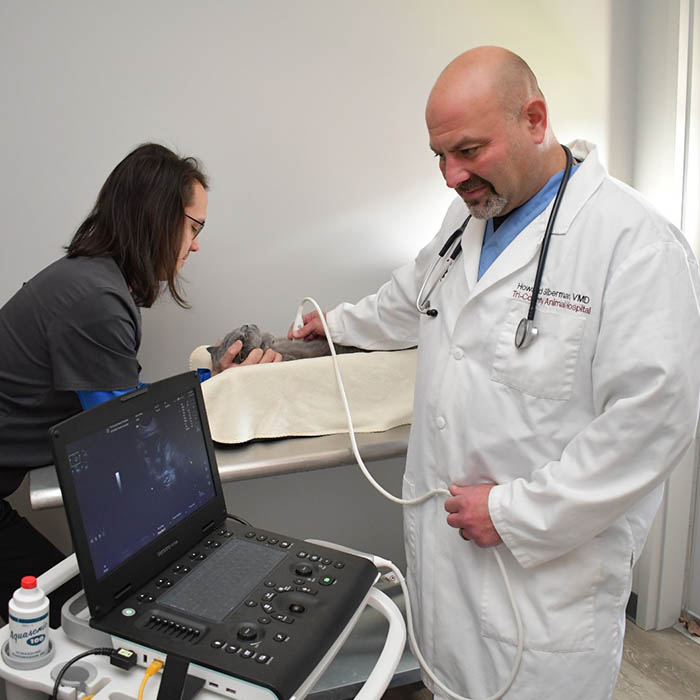What You Required to Learn About Veterinary Solutions: An Introduction of Diagnostic Devices and Procedures
Vet solutions play an important duty in maintaining the health and wellness of family pets. Normal exams can disclose concealed health and wellness worries early. Numerous diagnostic devices and treatments, such as blood examinations and imaging techniques, provide necessary insights into a pet's health. Comprehending these techniques is essential for pet dog proprietors. What particular analysis procedures are most generally used, and just how can they impact an animal's therapy plan?
Relevance of Normal Vet Check-Ups
While several pet dog proprietors might ignore the value of routine vet check-ups, these consultations are crucial for maintaining a pet's overall health and wellness. Routine visits to the vet permit very early discovery of possible health and wellness concerns before they escalate right into major issues. Regular examinations frequently consist of vaccinations, which are essential for protecting against contagious diseases that might significantly impact an animal's well-being. In addition, these visits give a chance for vets to examine the pet's weight, dental health and wellness, and overall problem, guaranteeing that the pet dog is flourishing. During these gos to, pet dog owners can also receive useful guidance on diet plan, workout, and preventive care tailored to their specific pet dog's requirements.
Usual Diagnostic Procedures in Vet Medication
In vet medication, exact medical diagnosis is important for reliable treatment. Typical diagnostic procedures consist of blood testing techniques, progressed imaging innovations, and urinalysis, each playing a significant function in identifying health problems. Understanding these methods boosts the ability to provide proper take care of animal patients.
Blood Testing Strategies
Blood screening techniques function as important analysis tools in vet medicine, enabling vets to assess the health of pets accurately. These methods involve collecting blood samples to assess different components, such as white and red blood cells, platelets, and biochemical pens. Typical tests include complete blood counts (CBC), which examine total health and wellness and discover infections, and biochemical panels, which evaluate organ feature and metabolic status. Additionally, serological tests can identify particular illness via antibody discovery. Blood testing is minimally intrusive and offers important information that helps in detecting conditions, monitoring health condition, and reviewing responses to therapies. Overall, these techniques play an important duty in guaranteeing excellent care for animals and animals alike.
Imaging Technologies Utilized
Diagnostic imaging modern technologies are essential tools in veterinary medicine, complementing blood screening methods by providing visual insights into an animal's internal frameworks. Typical imaging methods consist of X-rays, which are beneficial for reviewing bone cracks and detecting foreign objects, and ultrasound, which permits real-time visualization of soft tissues and organs. Magnetic vibration imaging (MRI) offers comprehensive photos of intricate physiological areas, particularly in neurological assessments. Calculated tomography (CT) provides cross-sectional images, enhancing analysis precision for various conditions. Each of these modern technologies help veterinarians in detecting diseases, intending treatments, and keeping track of recovery. By integrating imaging technologies, vet professionals can much better analyze a pet's health and make informed decisions regarding their care.
Urinalysis and Diagnostics
Urinalysis works as an important analysis tool in vet medication, giving useful insights right into an animal's total wellness and helping in the discovery of different conditions. This non-invasive treatment analyzes urine examples to examine kidney function, hydration status, and metabolic disorders. Common components checked out include details gravity, pH degrees, glucose, healthy proteins, and the presence of blood or germs. Irregular searchings for can show issues such as urinary tract infections, diabetes mellitus, or kidney illness. To enhance diagnostic precision, urinalysis is commonly carried out together with various other examinations, such as blood work and imaging research studies. Early discovery via urinalysis can result in prompt interventions, boosting the diagnosis for lots of veterinary people. It is an important facet of detailed veterinary care.
Comprehending Blood Examinations and Research Laboratory Analysis
Understanding blood examinations and laboratory evaluation is essential in vet medicine as it helps in identifying numerous wellness conditions in animals. Various types of blood tests supply essential details regarding an animal's internal state, while interpreting lab results calls for cautious factor to consider of numerous variables. This area will certainly discover the kinds of blood examinations offered and the significance of their outcomes.
Kinds Of Blood Tests
Blood examinations play an important function in vet medicine, providing crucial understandings right into a pet's wellness condition. Different kinds of blood tests are utilized, each serving various objectives. Full blood counts (CBC) examine general wellness and spot conditions such as anemia or infection. Biochemical accounts examine body organ function by determining electrolytes and enzymes, offering understandings right into metabolic health. Serological examinations determine certain antibodies or pathogens, assisting in the diagnosis of infections or autoimmune diseases. Blood inputting assurances risk-free transfusions, while coagulation tests gauge the blood's capability to clot, crucial for medical procedures. These examinations collectively boost diagnosis, therapy preparation, and surveillance of a pet's health and wellness, showing the significance of comprehensive lab evaluation in vet treatment.

Interpreting Laboratory Outcomes
A comprehensive evaluation of laboratory results is important for accurate diagnosis and therapy in vet medication. Analyzing laboratory results needs an understanding of regular recommendation arrays and the relevance of deviations. Blood examinations can expose various wellness indicators, such as body organ function, electrolyte balance, and the visibility of infections. Vets must take into consideration the entire professional photo, consisting of the pet's background, physical exam searchings for, and any type of signs and symptoms presented. Variations in outcomes might develop from elements such as age, breed, and underlying health and wellness conditions. As a result, laboratory results must not be seen alone but rather as component of a comprehensive analysis technique. Exact interpretation enables tailored therapy plans and far better outcomes for veterinary people.
Imaging Techniques: X-rays, Ultrasounds, and Beyond
Imaging strategies are crucial devices in veterinary medication, offering vital insights right into the wellness and wellness of animals. Among one of the most commonly made use of methods are Ultrasounds and x-rays. X-rays are invaluable for imagining bone structures, assisting veterinarians recognize fractures, tumors, you can try this out or foreign things. This method is quick and non-invasive, making it ideal for immediate situations.Ultrasounds, on the various other hand, make use of acoustic waves to produce photos of soft cells and organs. This strategy is particularly beneficial for taking a look at the heart, abdominal area, and reproductive body organs, allowing vets to examine problems like liquid buildup or organ abnormalities.Beyond X-rays and ultrasounds, progressed imaging strategies such as computed tomography (CT) and magnetic vibration imaging (MRI) are increasingly made use of in vet practice. These approaches provide detailed cross-sectional images, enhancing the precision of medical diagnoses and treatment strategies. Ultrasound For Dogs. On the whole, imaging strategies play a crucial duty in ensuring efficient vet care
The Duty of Biopsies in Diagnosing Family Pet Health And Wellness Issues
Precision in detecting health and wellness concerns in family pets commonly depends upon making use of biopsies, which give definitive information regarding tissue abnormalities. A biopsy entails the elimination of a small example of cells for assessment under a microscopic lense, permitting veterinarians to recognize various conditions, including infections, lumps, and inflammatory illness. This analysis device is important for identifying between benign and malignant growths, leading therapy decisions, and assessing the extent of a condition.Biopsies can be carried out utilizing different techniques, such as needle aspiration, incisional biopsies, or excisional biopsies, relying on the place and kind of cells entailed. The option of approach might affect recovery time and the quantity of tissue gathered. Eventually, the information obtained from a biopsy can bring about targeted treatments, enhancing end results for animals encountering significant wellness obstacles. Veterinarians highlight the significance of this procedure in accomplishing accurate medical diagnoses and efficient treatment plans.
Advanced Diagnostic Equipment: Endoscopy and CT Checks

Advanced analysis tools, such as endoscopy and CT scans, play a vital function in modern-day veterinary medication, using non-invasive approaches to imagine interior structures and diagnose different problems in pet dogs. Endoscopy includes using a flexible tube furnished with a cam, allowing vets to check out the stomach system and breathing system directly. This method can expose abnormalities such as tumors, foreign bodies, or swelling, making it possible for targeted therapy plans.CT scans, on the other hand, make use of advanced imaging technology to create comprehensive cross-sectional pictures of the body (CT Scans For Animals). This technique is especially valuable for examining facility structures like the mind, spinal column, and joints. By supplying high-resolution pictures, CT scans assist veterinarians in identifying issues that might not be evident with standard radiography. With each other, these innovative tools improve analysis precision, enhance therapy outcomes, and inevitably add to far better total family pet health and wellness monitoring

Translating Test Outcomes: What Family Pet Owners Should Know
Understanding examination outcomes can be a difficult job for pet dog owners, specifically after innovative treatments like endoscopy and CT scans have actually been carried out. Analyzing these outcomes requires a grasp of clinical terms and a clear understanding of what the searchings for show about the pet's health and wellness. Vets commonly supply descriptions, yet the intricacy of the results can still lead to confusion.Pet proprietors must actively engage in conversations with their vets, asking inquiries to clear site web up any uncertainties. It is vital to understand uncommon versus regular outcomes and the implications for the family pet's therapy plan. Furthermore, identifying that some results might call for further testing or monitoring can help owners remain notified regarding their pet dog's health and wellness journey. Ultimately, a joint technique in between pet dog proprietors and veterinary professionals fosters much better health results and enhances the general treatment experience for pets.
Frequently Asked Concerns
How Do I Choose the Right Vet Clinic for My Pet?
Choosing the ideal vet clinic involves looking into regional choices, examining credentials, seeing facilities, and examining team interactions (CT Scans For Animals). Focusing on suggestions from relied on resources can help guarantee the very best treatment and atmosphere for a family pet's health needs
What Should I Do if My Animal Refuses to Go to the Vet?
When a family pet refuses to visit the veterinarian, it's suggested to continue to be tranquil, use deals with or toys to tempt them, and think about arranging a home see if anxiousness continues. Patience and positive reinforcement are key.
Exist Telehealth Options for Vet Providers?
Telehealth choices for vet solutions are significantly readily available, enabling pet more proprietors to seek advice from veterinarians from another location. These solutions enable conversations concerning health issues, guidance on small ailments, and follow-ups without needing to check out a center.
Just how Commonly Should My Pet Have Oral Examinations?
The frequency of oral check-ups for animals typically depends upon their age and type. Usually, vets recommend annual dental assessments, although some pet dogs may call for even more constant check outs to preserve excellent dental health and wellness.

What Are the Expenses Connected With Vet Diagnostics?
The prices connected with veterinary diagnostics can vary extensively, normally varying from basic examinations like blood job to innovative imaging strategies. Aspects influencing costs include the clinic's place, tools used, and particular tests needed for each pet. Vet solutions play an important duty in preserving the health of pet dogs. While lots of animal proprietors might underestimate the significance of routine veterinary exams, these visits are necessary for keeping an animal's total health. In addition, these visits offer a chance for veterinarians to examine the animal's weight, dental wellness, and general problem, making certain that the pet dog is thriving. Accuracy in detecting health issues in pets typically pivots on the usage of biopsies, which offer clear-cut details about tissue problems. Additionally, recognizing that some outcomes may require further screening or surveillance can help proprietors remain notified regarding their pet's health journey.
Comments on “How CT Scans For Animals Help Vets Detect Internal Issues Early}”